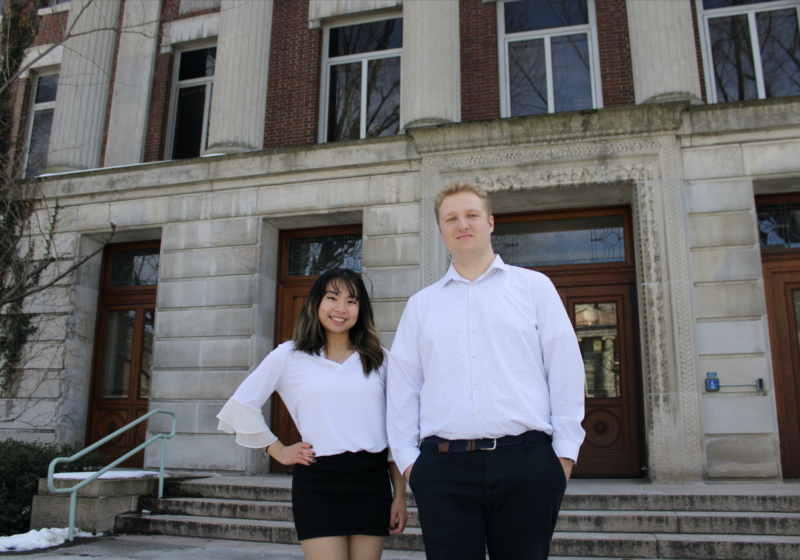Contemporary music has been notorious for raising more than a few eyebrows among classically trained musicians. After years of Mozart and Beethoven, some of these modern pieces have the same jolting effect as jumping into a cold pool, but once the listener gets used to the change, it’s not bad at all. In fact, like the cold water, contemporary music is a refreshing change.
Musica Nova’s performance on Monday night dispelled some of the negative myths of contemporary music, the biggest of these being its inaccessibility.
Led by director Mark Scatterday, the musicians gave a commanding performance full of technically challenging and musically demanding works. The group oozes unconventionality, but with pieces with titles like “Spam” and “Musicians Wrestle Everywhere,” their unconventionality is not only warranted, it is welcomed.
First off, the musicians have a stage presence that is miles away from that of the Eastman Philharmonia or any other classical ensemble. They saunter on the stage. They don’t do any warming up on stage before the performance begins. They aren’t even dressed in all black, a heinous dress code infringement in the world of classical performing ensembles.
As if to flaunt their unconventionality even further, one musician was even wearing sandals and red socks. Their blatant lack of adherence to traditional orchestra standards didn’t detract from the performance. Rather, it added to it.
The biggest difference between Musica Nova and the Philharmonia is that every musician on that stage radiated energy. The audience couldn’t help being swept up by it.
With an increased emphasis on the performance of contemporary music, even new music can start to sound clich. My first impression of the first piece, “Spam,” composed by Eastman alum Marc Mellits, was just that.
Like many other contemporary pieces, the motives were rhythmic rather than melodic, and in this case, were repeated to the brink of excess. It seemed to be a typical contemporary concert-opener, even throwing in some piano manipulation, which has become a fallback trick for composers looking to create something outside of the classical realm.
Just when it seemed that the rhythmic barrage of percussive chords would never end, the piece took an abrupt turn into an incredibly beautiful slower section. This section wasn’t melodic in the exact definition of the word, but the chord changes filled in with melodic fragments among the instruments ended the piece in a way that was a complete turnaround from the opening, and a very pleasant surprise.
The second piece, Withold Lutoslawski’s “Chain I,” began subtly, with single instruments introducing the chain motive. Despite the wide array of tambour of instruments, the phrasing and articulation of the theme was very well emulated throughout the orchestra.
As the piece progressed, the orchestration became increasingly more thick, and the individual parts more chaotic. However, the balance within the music was exemplary.
Even in the chaos, the important motives were perfectly clear. The music intensified to the ever popular, sometimes cheesy yet usually effective gong hit at the climax. The performance of “Chain I” was very successful in what seemed to be the ultimate goal of the piece, creating a mood. The feeling of intensity blanketed the hall through the end of the work.
The second half of the program opened with “Notebook” by Jorge Liderman. This was a nine minute long collection of eight movements. The movements were very short and ended abruptly, like random notes jotted in a notebook. It took a while to get used to the brevity and abruptness of the movements, but the notebook idea was very effective.
One of the middle movements was a piano solo played by Adam Roberts. This movement was longer than the rest and was a beautiful oasis from the spurts of intensity of the other movements. However, the highlight of this piece was watching percussionist Kate Hutchings make a mad dash between instruments between each movement. Percussion was key in “Notebook,” and Hutchings’ performance really made the piece come together.
The title of the last piece, “Musicians Wrestle Everywhere” by Judith Weir, created some doubt in my mind, as well as a few disturbing mental pictures. However, all doubt was erased once the piece began. The musicians’ energy was apparent from the first note. It was obvious that everyone on the stage loved the piece.
The audience ate it up, with good reason. “Musicians Wrestle Everywhere” was downright entertaining. Weir’s inspiration for the piece were the sounds on the streets of London. It was full of vibrant colors and rhythms.
The musicians’ heads were bobbing throughout the entire piece, and a few of them, when they didn’t have an instrument in their mouths, were smiling. It was a joy to watch and a great way to end the concert.
Musica Nova’s enthusiasm is contagious. Their stage presence and their performance made it obvious to the audience that they were having a good time. All music had to be new sometime, and who is to say that some of the works played at the concert will not be part of the standard repertoire in the future?
As Scatterday said, “[the performers] grew as musicians by performing those pieces.” There is no doubt in my mind that he was right.





